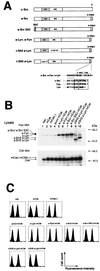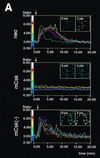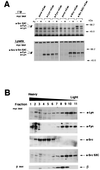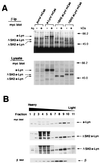Sequential requirements of the N-terminal palmitoylation site and SH2 domain of Src family kinases in the initiation and progression of FcepsilonRI signaling
- PMID: 10669752
- PMCID: PMC85358
- DOI: 10.1128/MCB.20.5.1759-1771.2000
Sequential requirements of the N-terminal palmitoylation site and SH2 domain of Src family kinases in the initiation and progression of FcepsilonRI signaling
Abstract
Initial biochemical signaling originating from high-affinity immunoglobulin E receptor (FcepsilonRI) has been ascribed to Src family kinases. To understand the mechanisms by which individual kinases drive the signaling, we conducted reconstitution experiments: FcepsilonRI signaling in RBL2H3 cells was first suppressed by a membrane-anchored, gain-of-function C-terminal Src kinase and then reconstructed with Src family kinases whose C-terminal negative regulatory sequence was replaced with a c-myc epitope. Those constructs derived from Lyn and Fyn, which are associated with detergent-resistant membranes (DRMs), physically interacted with resting FcepsilonRI and reconstructed clustering-induced signaling that leads to calcium mobilization and ERK1 and -2 activation. c-Src-derived construct, which was excluded from DRMs, failed to interact with FcepsilonRI and to restore the signaling, whereas creation of palmitoylatable Cys3 enabled it to interact with DRMs and with FcepsilonRI and to restore the signaling. Deletion of Src homology 3 (SH3) domain from the Lyn-derived construct did not alter its ability to transduce the series of signaling. Deletion of SH2 domain did not affect its association with DRMs and with FcepsilonRI nor clustering-induced tyrosine phosphorylation of FcepsilonRI beta and gamma subunits, but it almost abrogated the next step of tyrosine phosphorylation of Syk and its recruitment to FcepsilonRI. These findings suggest that Lyn and Fyn could, but c-Src could not, drive FcepsilonRI signaling and that N-terminal palmitoylation and SH2 domain are required in sequence for the initial interaction with FcepsilonRI and for the signal progression to the molecular assembly.
Figures











Similar articles
-
Structure-function analysis of Lyn kinase association with lipid rafts and initiation of early signaling events after Fcepsilon receptor I aggregation.Mol Cell Biol. 2001 Dec;21(24):8318-28. doi: 10.1128/MCB.21.24.8318-8328.2001. Mol Cell Biol. 2001. PMID: 11713268 Free PMC article.
-
Differential involvement of Src family kinases in Fc gamma receptor-mediated phagocytosis.J Immunol. 2000 Jul 1;165(1):473-82. doi: 10.4049/jimmunol.165.1.473. J Immunol. 2000. PMID: 10861086
-
SH2 domain-mediated targeting, but not localization, of Syk in the plasma membrane is critical for FcepsilonRI signaling.Blood. 2001 Mar 1;97(5):1352-9. doi: 10.1182/blood.v97.5.1352. Blood. 2001. PMID: 11222380
-
Protein-tyrosine kinases and adaptor proteins in FcepsilonRI-mediated signaling in mast cells.Curr Mol Med. 2003 Feb;3(1):85-94. doi: 10.2174/1566524033361618. Curr Mol Med. 2003. PMID: 12558077 Review.
-
The role of Src family kinases in mast cell effector function.Novartis Found Symp. 2005;271:39-47; discussion 47-53, 95-9. Novartis Found Symp. 2005. PMID: 16605127 Review.
Cited by
-
Roles for SH2 and SH3 domains in Lyn kinase association with activated FcepsilonRI in RBL mast cells revealed by patterned surface analysis.J Struct Biol. 2009 Oct;168(1):161-7. doi: 10.1016/j.jsb.2009.04.012. Epub 2009 May 7. J Struct Biol. 2009. PMID: 19427382 Free PMC article.
-
Structure-function analysis of Lyn kinase association with lipid rafts and initiation of early signaling events after Fcepsilon receptor I aggregation.Mol Cell Biol. 2001 Dec;21(24):8318-28. doi: 10.1128/MCB.21.24.8318-8328.2001. Mol Cell Biol. 2001. PMID: 11713268 Free PMC article.
-
Fcepsilon- and Fcgamma-receptor signaling in diseases.Springer Semin Immunopathol. 2006 Dec;28(4):365-75. doi: 10.1007/s00281-006-0051-2. Epub 2006 Nov 15. Springer Semin Immunopathol. 2006. PMID: 17106671 Review.
-
Function of Protein S-Palmitoylation in Immunity and Immune-Related Diseases.Front Immunol. 2021 Sep 7;12:661202. doi: 10.3389/fimmu.2021.661202. eCollection 2021. Front Immunol. 2021. PMID: 34557182 Free PMC article. Review.
-
Cellular palmitoylation and trafficking of lipidated peptides.J Lipid Res. 2007 Aug;48(8):1873-84. doi: 10.1194/jlr.M700179-JLR200. Epub 2007 May 24. J Lipid Res. 2007. PMID: 17525474 Free PMC article.
References
-
- Amoui M, Draberova L, Tolar P, Draber P. Direct interaction of Syk and Lyn protein tyrosine kinases in rat basophilic leukemia cells activated via type I Fcɛ receptors. Eur J Immunol. 1997;27:321–328. - PubMed
-
- Aoki Y, Kim Y T, Stillwell R, Kim T J, Pillai S. The SH2 domains of Src family kinases associate with Syk. J Biol Chem. 1995;270:15658–15663. - PubMed
-
- Beaven M A, Metzger H. Signal transduction by Fc receptors: the FcɛRI case. Immunol Today. 1993;14:222–226. - PubMed
-
- Benhamou M, Ryba N J, Kihara H, Nishikata H, Siraganian R P. Protein-tyrosine kinase p72syk in high affinity IgE receptor signaling. Identification as a component of pp72 and association with the receptor γ chain after receptor aggregation. J Biol Chem. 1993;268:23318–23324. - PubMed
Publication types
MeSH terms
Substances
LinkOut - more resources
Full Text Sources
Other Literature Sources
Miscellaneous
